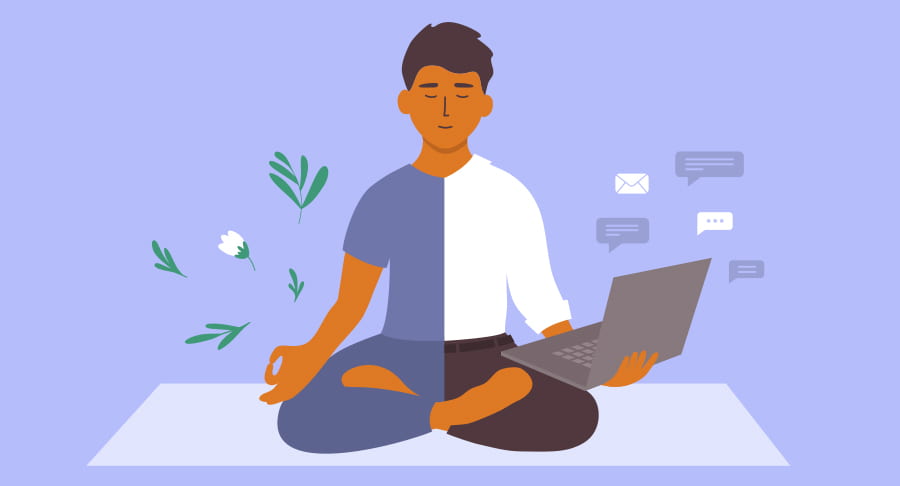Incorporating Wellness Into Your Meetings Helps Attendees Thrive

Wellness has been growing in the meeting and event space. Why? Events for planners and attendees can be stressful.
Wellness isn’t just about fitness: it’s much more. Wellness is the “act of practicing healthy habits to attain better physical and mental health outcomes.” So, instead of your attendees just surviving day-long meetings and events, you can help them thrive.
Promoting wellness tells your attendees that you care about their well-being.
To help you understand just how to integrate wellness into your next meeting or event, we’ve curated a list of wellness activities and strategies that will meet the needs of your attendees all day long.
Include Meditation or Yoga
Engagement can begin to suffer during a straight day full of programming. Incorporating wellness breaks can help keep your attendees from becoming overwhelmed with information. Meditation and yoga are familiar holistic approaches that can help your attendees reduce stress and anxiety, re-center themselves, refocus their attention, and recharge their brains.
Meditate between meetings
According to mindfulness coach Brad Reed, “Actively relaxing between meetings using practices such as meditation, reduces the build-up of stress by lowering beta-brainwave activity. This has been previously shown to improve creativity, happiness, performance, communications, empathy, and productivity!”
A great place to begin a habit of meditating is at the start or end of a meeting (or both!) by having employees breathe or relax for 5 minutes (try this). In addition, it’s easy to have quiet rooms supplied with cushions – giving guests an opportunity to meditate during longer breaks.
Did you know, research shows that increased practice of mindfulness meditation or exercise may protect against the common cold and flu?
Yoga and stretching sessions
Yoga focuses on strength, flexibility, breathing, and relaxation. After a single session participants experience benefits like lower blood pressure and improved mood – a nice benefit to offer to your event participants.
Yoga can come in many forms – from chair yoga to office yoga to sessions on the mat.
- Chair yoga is a great option when attendees are stuck in a tight room for a long time and without much space to move around. Here are five poses to get you started.
- Office yoga is a blend of both chair and standing poses you can do in a single spot using the chair for support if needed. This set of 8 poses can easily be incorporated into a meeting to help relax and refresh guests.
- 30-minute yoga sessions available throughout a multi-day conference or event can be transformative. This may seem like a big undertaking, but in actuality, it’s a gesture that offers a lot while requiring little effort and equipment. Teaming up with a yoga instructor or studio will make the process run smoothly.
Try Tapping
Tapping (aka Emotional Freedom Technique or EFT) has been used effectively with individuals experiencing burnout, stress, and anxiety, by helping to restore the body’s energy and bring it into balance. Tapping is a five-step technique that uses a specific pattern of gently tapping on the nine meridian points while focusing on the stress you want to address. It’s easy to learn and can be done anywhere, anytime. A certified therapist can guide attendees through tapping sessions that can last from 2-10 minutes.
Designate Quiet Spaces
To address mindfulness in a creative way, consider designating a few meeting rooms as ‘quiet spaces,’ allowing attendees to utilize them for a break from events. Activities such as reading, coloring books, modeling clay or knitting, can be supplied or guests can bring their own.
Take a Walk
Walking has been hailed as the ultimate exercise as it naturally uses the entire body. Plus it releases endorphins which produce a general feeling of well-being! You can help re-energize your attendees, improve their cognitive performance, mood, and increase their blood flow, by simply integrating walking into your event.
If attendees have to move between locations, encourage walking instead of shuttling. On a scenic university campus, a quick self-guided walking tour past historic buildings or through greenways might take a few extra minutes, but the benefits last for hours.
Take the Break Outside
Plan an outdoor breakout session – it might be just the ticket to relax, inspire, and awaken attendees. Choosing venues with quick access to green spaces is a great way to change up the scenery while enjoying the fresh air and sun, which tends to improve mood and encourage more attendee participation.
According to the Global Wellness Trends Report, “People are seeking ways to embrace wellness, and new models of thoughtfully choreographed events with wellness could be just the ‘nudge’ they need,” states the report. It describes this trend of putting “wellness at the core” of events as a way to reinforce “the importance of what is now top of mind everywhere — health, safety, strengthening immunity and employing protocols and technologies that can mitigate risk.
– Northstar Meetings Group
Rethink Seating
The effects of long periods of sitting have become a hot topic, and more often than not it’s just hard to avoid. From floor cushions to ball chairs, people are finding ways to sit dynamically while also improving their posture. If you know attendees are in for a long event, how can you provide dynamic sitting options? Consider what one summit did: They were asked to think creatively about social distancing for a large gathering. “We didn’t want a ballroom that had a lot of empty space and felt weird,” says Nancy Davis, chief creative officer and executive director of the Global Wellness Institute. “But when it’s set up to look like a high-end fitness facility [with recumbent bikes or stability balls instead of chairs], that space looks like a natural distance.”
Add Screen-Free Zones
There’s no denying it, screens can be a distraction. According to researcher Andrew Ward and a study done at the University of Texas at Austin, “The mere presence of [a] smartphone was enough to reduce cognitive capacity.” To help attendees live more in the moment and increase retention rates, promote screen-free zones, screen-free breakout sessions and networking events.
Offer Chair Massage
Massage can increase productivity and morale and decrease stress. Just 15-minutes of chair massage to the neck, back, arms and hands has been scientifically proven to improve circulation, fight stress and anxiety, restore energy levels, and help keep the body injury-free.
Just Breathe!
Did you know that just the way we breathe can have profound effects on our mental and physical health? It may even help strengthen our immune systems.
Bonus! Bringing breathwork to large audiences costs very little. A good practitioner can guide attendees in proper techniques beginning with breath awareness, breathing skills, and applying breathwork to everyday life.
Making Wellness a Priority
Science shows us that most of these wellness strategies can combat the stress and fatigue that can result in a long day of back-to-back meetings, workshops, seminars, and multi-day conferences. Our Conference Services Team can help you incorporate any of these wellness activities into your next meeting or event so you can help invigorate your attendees and perhaps introduce them to beneficial habits that they can use well into the future.
Ready to take the next step? Check out The Virden Retreat Center, our secluded coastal venue that’s a perfect match for meetings and wellness.


